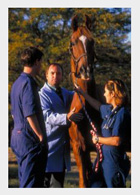Equine Health Information and Resources
Request to Receive Animal Disease SMS Text Alerts
The California Department of Food and Agriculture, Animal Health Branch (AHB) plays a significant role in protecting California’s equine population through equine disease surveillance, regulatory disease control and prevention programs. The equine industry plays a critical role in the economic infrastructure of California, therefore its protection is a top priority within the Department. According to the American Horse Council census, California has approximately 700,000 horses and has a total economic impact valued at approximately $7 billion. The equine industry generates approximately 54,200 direct jobs and 130,200 total jobs across the state of California.
The AHB is a national leader in addressing situations which threaten the health of the equine industry. It is the Branch’s responsibility to react promptly to threatening situations and address equine diseases of concern. Regulatory disease response to a suspicious or confirmed case depends on the disease agent, the clinical manifestation of the disease and the biosecurity measures implemented on the premises. Working with a private practitioner to establish appropriate vaccination protocols and implement biosecurity measures appropriate for your horse and premises is an essential part of preventing disease.
-
Contagious Equine Metritis (CEM) is a highly contagious venereal Foreign Animal Disease of horses caused by the bacteria, Taylorella equigenitalis. Transmission occurs during natural cover or artificial insemination breeding. The disease is not known to affect humans or other species of livestock.
For more information see our Contagious Equine Metritis webpage.
-
Equine Herpes Virus–1 (EHV–1) infection in horses can cause respiratory disease, abortion in mares, neonatal foal death and neurological disease. he virus is not transmissible to humans. The neurological form of the disease is known as Equine Herpes Myeloencephalopathy (EHM). Damage to the blood vessels in the brain and spinal cord associated with EHV–1 infection cause neurological signs to appear. EHM is most often due to the neuropathologic strain of EHV–1, but may occasionally be caused by the non-neurologic strains of the virus.
For more information see our Equine Herpes Virus webpage.
-
The Equine Infectious Anemia (EIA) virus belongs to the family Retroviridae. This group of viruses includes human immunodeficiency virus (HIV), the immunodeficiency viruses of apes and monkeys (SIV), goats (CAEV), cats (FIV) and cattle (BIV). The virus persists in the horse's white blood cells, and in the plasma (non-cellular portion of the blood) during febrile episodes.
For more information see our Equine Infectious Anemia webpage.
-
Equine piroplasmosis (EP) is a blood-borne disease of equids (horses, donkeys, mules and zebras) caused by one of two protozoan parasites, Theileria equi or Babesia caballi. The U.S. is considered “free” of this disease. Positive cases must be reported to state or federal animal health officials.
For more information see our Equine Piroplasmosis webpage.
-
Rabies is a viral disease affecting all mammals that is invariably fatal if not treated. Cases are diagnosed in livestock, as well as in dogs, cats, and wildlife. CDFA, along with the California Department of Health Services, monitors cases in livestock.
For more information see the Department of Health Services Center for Disease Control webpage.
-
Screwworms are fly larvae (maggots) that feed on living flesh. These parasites can infect any warm-blooded animal. Screwworms enter wounds as small as an insect bite and feed on living tissue in the area. If untreated, screwworm infestations can be fatal. In the U.S., Screwworm is a Foreign Animal Disease reportable within 24 hours of diagnosis. Screwworms have most recently entered the U.S. in dogs that have been imported from areas of the world where the flies are endemic.
For more information see our New World Screwworm web page.
-
Vesicular stomatitis (VS) is a virus caused disease that primarily affects cattle, horses and swine. The disease can also affect many other species of animals and has occurred in sheep, goats, wildlife and occasionally humans. The major significance of the disease is its’ nearly identical appearance to the truly devastating foot and mouth disease, which was eradicated from the U.S. nearly seven decades ago.
For more information, see our Vesicular Stomatitis webpage.
-
West Nile Virus (WNV) is a mosquito-borne virus first detected in the U.S. in the New York City area in 1999. Since 1999, the virus has spread throughout the U.S. and Canada, infecting birds, humans, horses, and other animals. As of 2015, more than 27,000 horses in the U.S. have been infected since the disease was first identified. The virus is maintained in the wild bird population and is spread between birds by mosquitos. Birds are considered the natural reservoir for WNV since high levels of virus circulate in their bloodstream. Mosquitos acquire WNV in blood meals from infected birds and pass it on to other birds, animals, and people. Mosquitos that feed on an infected horse or human have not demonstrated the ability to ingest enough of the virus to transmit it to other animals or humans; therefore, horses and humans are considered “dead end hosts.”
For more information, see our West Nile Virus webpage.
Equine Resources
More Resources
Follow Us
Contact Us
CDFA Animal Health and Food Safety Services,
Animal Health Branch
Sacramento, California 95814
Phone: 916-900-5002
Fax: 916-900-5333
Email: ahbfeedback@cdfa.ca.gov


